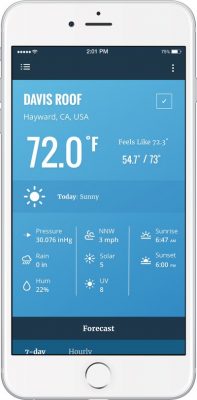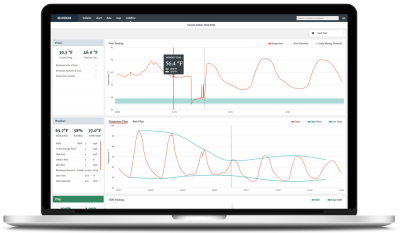Davis has posted a new video describing and explaining how to use Weatherlink 2.0. (30th Dec)
This blog post will be further updated as new information becomes available during 2018.
Background
Important information for all Weatherlink and weatherlink.com users: Davis has announced the launch of Weatherlink.com 2.0 as from 28th November 2017. If you’ve been wondering why development of Weatherlink software seems to have ground to a halt over the past year or two we now have the answer. First a little background for any new/potential users:

Weatherlink.com is the Internet cloud platform that Davis operates for viewing your weather data online in a web browser or via a mobile app. This blue‑sky presentation (right) is probably the most familiar data view of the existing platform. The data originates from any one of three Davis weather station configurations: a PC or Mac running the Weatherlink program; the WeatherlinkIP logger; or a remote Vantage Connect unit. At the last count there were over 26, 000 users worldwide actively uploading data to Weatherlink.com, including roughly 1000 UK contributors, making it one of the largest global weather networks.
Earlier this year, Davis launched their new EnviroMonitor (EM) range providing for much more flexible remote monitoring of the environment, as outlined in a previous news post with more detail on our dedicated EnviroMonitor website. A key part of the EM system is an impressive new online platform for processing and viewing the EM data, including sophisticated smartphone apps. One example of the customisable dashboard on an iPad is shown below (click to enlarge).

It’s now clear that this new EM data platform is also intended for use with data from existing Vue and VP2 weatherlink.com stations as well as EM and this overall Davis platform is being termed ‘weatherlink.com 2.0’. The WL 2.0 map will therefore show both EM and Vue/VP2 stations. (The map will look quite sparse initially as it will only show new registrants to start with, but will then fill out as all existing weatherlink.com users are progressively migrated across to 2.0 during 2018.)
Put another way, weatherlink.com 2.0 is a major step towards moving the whole of the Weatherlink for Windows functionality online into a cloud application. There are still a few functions not included as yet, but should mostly appear in planned future updates.
This new platform is now being rolled out to both new and existing users of weatherlink.com, as explained below. One caveat: we have answers to most questions, but a few details are not yet 100% clear – we’ll aim to clarify these as soon as possible. Existing and prospective customers are welcome to contact us with any questions.
Weatherlink.com 2.0: feature levels and timetable
As from 28th November 2017, all new subscribers to weatherlink.com will automatically see and be registered to the 2.0 platform. Existing subscribers will be migrated across automatically, all to be completed by June 2018. Users will be advised by email as and when migration of their data has occurred.
The new weatherlink.com 2.0 platform will be a two-tier system, with two levels of features: ‘Basic’ and ‘Pro’.
The Basic level will be free to use, but account registration is still required. The Pro level, with more advanced features, will have an annual subscription (£54). The Weatherlink smartphone app will continue to be free to download. (There is also now a second smartphone app called Mobilize – see below.)
Basic level corresponds essentially to the features that are available now with the existing weatherlink.com service, but in a considerably updated format. Pro level adds several sophisticated new features including online charting and data-browsing capabilities together with data-sharing; further Pro level features are in the development pipeline too.
Weatherlink.com 2.0: key features
Weatherlink.com 2.0 is a platform with many features and with more to come; in this short blog article we can only highlight the main points. Just as a reminder to potential new users, the weatherlink.com features described here are all delivered via the Internet using a standard web browser or a smartphone app. The features are therefore available anywhere on any device that has Internet or WiFi or cellular access, as appropriate to the device.
Basic level

The Basic level service provides five main features:
- Bulletin (or dashboard) showing a customisable visual snapshot of the latest weather conditions;
- A worldwide map with access to the live Bulletin data for any station set up as ‘public’;
- Automatic uploads can be set up to other weather networks such as Weather Underground;
- Use of the Weatherlink Mobile App 2.0 (see right) – a totally redesigned version of the app, including new features, e.g. 7-day forecast;
- Storage of your 10, 000 most recent archive data records for download into Weatherlink for Windows;
This feature-set is largely as for the existing weatherlink.com service, but the big change that users will see is the greatly enhanced dashboard/Bulletin feature – see iPad example above – and the fully rewritten smartphone app. The other major change is clearly the option to upgrade to the Pro level:
Pro level
Pro level adds several features to the Basic level:
- Charting – a powerful multi-parameter charting facility – similar in principle to the Chart feature of the Weatherlink program, but in a modern browser presentation;
-

Mobilize feature (click to enlarge) Data: Broadly replicates the Browse function of the Weatherlink program offering:
- Viewing of past data in a spreadsheet-type table
- Export data in CSV text format
- Full, long-term storage of archive data records
- Future option to upload existing monthly Weatherlink archive files
- The Mobilize browser feature (see image right) and smartphone app: Separate from the Weatherlink app, this allows more customised data views to be set up plus special reports for Frost, Weather, Crop and Irrigation;
- More advanced data sharing options – to allow data to be shared more fully between users. This option should be available in Q2 2018;
Current omissions
Weatherlink.com 2.0 is clearly not yet fully complete – at least a couple of feature areas are currently missing e.g.:
- A reporting tool such as NOAA reports. For the time being at least this will continue to require downloads to Weatherlink for Windows or use of a third-party platform such as Prowlar;
- A tool for uploading data to the user’s own website in the user’s own preferred style and format;
We understand that both are indeed on the roadmap for weatherlink.com 2.0 and likely to appear in a future version during 2018, probably at the Pro level.
Updates
Updates as points are clarified or further information is made available by Davis:
-
Currently only EM stations can be shared across 2.0 accounts. Full sharing is coming but will likely only be available across Pro level accounts. Sharing specifically of EM stations is enabled via the Enviromonitor mobile app (12th Dec);
-
The download of archive data into Weatherlink for Windows will continue to be possible in 2.0 (12th Dec);
-
The future of the XML current conditions response is unclear. The basic XML request is still recognised in 2.0 but the XML tree returned is not populated with data. (12th Dec);
Further information
The weatherlink.com launch and migration process represents a fairly major change and there will be a number of other questions about detailed implementation. In particular, we’re still awaiting details about exactly how the upgrade to the Pro level can be purchased – we’ll update this blog as soon as we know more. But we believe that the two Basic and Pro levels will be introduced as follows:
New or migrated users running a local copy of Weatherlink on PC or Mac, or using a WeatherlinkIP logger, will be able to access the Basic level by default. Upgrading to the subscription-based Pro level will be fully optional but newly registered users will receive a free 30-day trial of the Pro level (before reverting back to Basic if a subscription is not taken out).
Users of Weatherlink for Windows/Mac and new WeatherlinkIP users should be able to register a Basic level account immediately and should also be able to trial the Pro level immediately and for the duration of the 30-day trial period. We would expect that by end-December (ie expiry of the Pro trial) the process to purchase the Pro upgrade option should be clarified.
Connect users, who will already be using a subscription plan, will automatically receive the Pro level service – the Pro cost will effectively be included within the Connect data plan prices. New Connect users (post 28th Nov) should see the Pro service immediately. Existing Connect users will need to await migration.
Existing Weatherlink subscribers who are migrated over to the new platform during 2018 will receive the Pro level service for a pro rata period depending on the expiry date of their existing subscription. At the end of the pro rata period, users can then decide whether to renew the Pro level subscription or fall back to the free Basic level. We still await full details of how this process will work.
Other points in brief:
-
The fully updated Weatherlink for Mobile 2.0 smartphone app is now available for download from your app store (but note that this is only for use with sites that are on or have migrated to the 2.0 platform);
-
weatherlink.com 2.0 accounts can be created by any user with an email address via the Signup button at weatherlink.com and before even owning a Davis station. Owning a free account will be mandatory to view data on browser or smartphone app;
-
No changes of weather station configuration or PC are necessary at the user end when migration occurs;
-
The 3-year plan is no longer available, but existing 3-year plans will be honoured;
-
Existing 1-year plans that fall due for renewal between now and before migration occurs can be renewed as at present by buying a new 6558 subscription;
-
Access to the Weatherlink.com 2.0 uses DID (your device ID) and password rather than user name and password as at present;
-
The existing blue-sky web page (accessed via an ‘old Weatherlink’ link) will remain available probably until the end of June 2018 and then for a further transition period, yet to be advised, but will be turned off thereafter. So, for better or for worse (though it’s not obvious why there would be anything other than upside) all users will need to switch to the 2.0 presentation by e.g. the end of 2018;
-
weatherlink.com 2.0 will permit registering multiple stations to a single account (but each station may be registered to only one account);
-
Pro level data features (data/chart/Mobilize) can only be shared with other Pro level users
-
Data upload intervals are unchanged from the current schedule with Weatherlink 2.0, current conditions upload every minute while archive records upload hourly. Connect units differ in that current and archive data are essentially the same and upload at the data plan interval;
-
Weatherlink for Windows and Mac will continue to be available but no further feature updates are planned at all (other than possible maintenance releases to ensure compatibility with e.g. weatherlink.com or newer operating system versions). Davis clearly see weatherlink.com 2.0 as the primary way in which users will wish to process weather data in the future;
-
The Web Download API for archive data in binary format is understood to be continuing essentially unchanged on the 2.0 platform (except that user name in the download request will need to be replaced by DID), but the status of the XML API is unknown;
-
weatherlink.com 2.0 is not compatible with uploads from an Envoy8X console;
